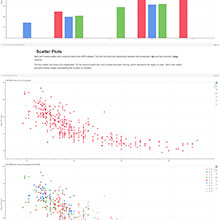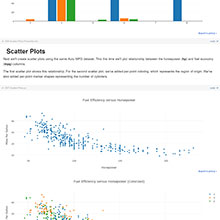Adds the specified data frame to the display in a nicely formatted scrolling table.
Any
The pandas data frame to be rendered to a table.
float
The display scale with units of fractional screen height. A value of 0.5 constrains the output to a maximum height equal to half the height of browser window when viewed. Values below 1.0 are usually recommended so the entire output can be viewed without scrolling.
0.7
bool
Whether or not the index column should be included in the displayed output. The index column is not included by default because it is often unnecessary extra information in the display of the data.
False
int
This argument exists to prevent accidentally writing very large data frames to a table, which can cause the notebook display to become sluggish or unresponsive. If you want to display large tables, you need only increase the value of this argument.
500
int, NoneType
When set to a positive integer value, the DataFrame will be randomly sampled to the specified number of rows when displayed in the table. If the value here is larger than the number of rows in the DataFrame, the sampling will have no effect and the entire DataFrame will be displayed instead.
None
str, typing.Any, str, str, str, typing.Any, str
An optional dictionary that, when specified, should contain a mapping
between column names and formatting strings to apply to that column
for display purposes. For example, {'foo': '{:,.2f}%'} would
transform a column foo = [12.2121, 34.987123, 42.72839] to
display as foo = [12.21%, 34.99%, 42.73%]. The formatters should
follow the standard Python string formatting guidelines the same as
the str.format() command having the value of the column as the only
positional argument in the format arguments. A string value can also
be specified for uniform formatting of all columns (or if displaying
a series with only a single value).
None



